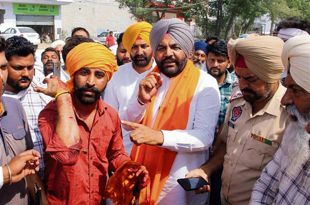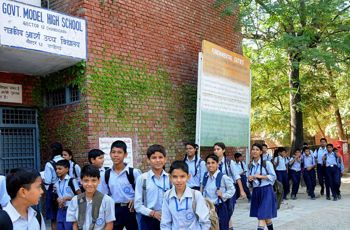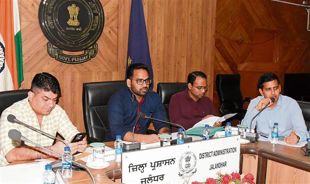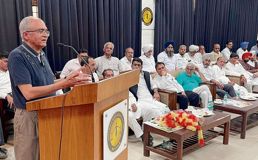
High blood pressure can be fatal, yet most people do not take it seriously, often refusing to have medicines despite the diagnosis. ISTOCK
Sachin Mittal
VIVEK (47), a bank manager, during his annual medical examination, was noted to have blood pressure (BP) of 160/96. Even during the previous check-ups, his BP readings had been dangerously high, but Vivek avoided taking medications prescribed for hypertension. The reason being, he did not exhibit any symptoms of hypertension like headache and dizziness and felt no discomfort in his day-to-day working or routine.
 This time, however, there were alarming though invisible complications. His test reports showed mild derangement of kidney function parameters. Further evaluation of his eyes showed changes in retina due to high BP. Unfortunately, Vivek is not the only patient who avoids taking prescribed medications despite being diagnosed with hypertension, called a silent killer as there are no visible or apparent symptoms. A majority of high BP patients (whose BP is 140/90 mmHg or higher and/or those taking medication for hypertension) either get diagnosed late and/or do not take medication even after diagnosis.
This time, however, there were alarming though invisible complications. His test reports showed mild derangement of kidney function parameters. Further evaluation of his eyes showed changes in retina due to high BP. Unfortunately, Vivek is not the only patient who avoids taking prescribed medications despite being diagnosed with hypertension, called a silent killer as there are no visible or apparent symptoms. A majority of high BP patients (whose BP is 140/90 mmHg or higher and/or those taking medication for hypertension) either get diagnosed late and/or do not take medication even after diagnosis.
These findings have been highlighted in the first-ever report by the World Health Organisation that says that out of 188.3 million adults (aged 30-79 years) with hypertension in India, only 37 per cent get diagnosed, just 30 per cent start treatment and merely 15 per cent manage to keep their BP under control. The irony though is that many get diagnosed only when high BP starts causing other complications.
These numbers, while scary, raise important questions — why are people not getting diagnosed in time and even after diagnosis, why is there a reluctance to accept it as a serious medical issue that needs active treatment?
This could be due to the silent nature of the ailment and lack of signs and symptoms, especially in early stages. Very few people are diagnosed at an early stage, not many start treatment and even fewer have their BP under control. People with very high BP (usually 180/120 or higher) can experience severe headaches, chest pain, dizziness, difficulty in breathing, nausea, vomiting, blurred vision, confusion, buzzing in the ears, nosebleeds and abnormal heart rhythm.
Untreated, uncontrolled high BP over a long period can not only lead to heart attack, stroke, blindness and kidney failure, but also irreversibly damage the heart, kidneys and eyes.
It’s ironical that despite availability of safe, cost-effective treatment options for hypertension, many people still develop complications which can be prevented with timely treatment. This is in contrast to another silent killer, diabetes, where again many patients are in denial initially, but still are more receptive to seek and take medical care. Perhaps, the obvious, visible derangement of blood glucose values in test reports or glucometers plays a part in that.
In hypertension, lab reports show abnormal readings only after substantial damage has been done.
Those at risk
Elderly, or even the young with a family history, those overweight or obese, those not physically active, eating a high-salt diet with excess of junk or processed foods, drinking too much alcohol, acutely mentally stressed and keeping irregular sleep schedules, are at a high risk of developing hypertension.
Preventive measures
Some simple lifestyle changes include eating healthy, cutting down on salt, not smoking or drinking, regular physical activity, reducing stress, improving sleep and above all, once diagnosed, taking medications regularly.
Doctors recommend adopting a DASH diet (dietary approaches to stop hypertension). It includes restricting salt, eating more fruits and vegetables, eating less refined food and sugar and having more whole grains and low-fat dairy foods. This diet also includes lean meat, fish, poultry, nuts and beans and limits sugary beverages, red meat, junk food and added fats as most processed foods contain high amounts of salt, sugar and fat. The government should implement policies to consciously reduce salt intake in diet. Weight loss, in case of obesity or overweight, can go a long way in reducing high BP and related complications.
For those diagnosed with hypertension, starting treatment/medications and their continuation, with three to four medical follow-ups a year, are of vital importance, as the doctor can adjust dosages for optimal BP control. In between visits to doctor, self-monitoring of BP at home is a must.
Also, these patients should totally avoid self-medication or self-change/adjustment in dosages as it can warrant many side-effects. Missing medications even for a small period can lead to a sudden spike in BP and trigger complications and thus, must be avoided. Also, many people, once their BP is controlled, stop taking medication on their own. This must be strictly avoided. Let a doctor take this call on any change or discontinuation of medication. Normally, medication is a life-long process but can be tapered or stopped altogether on a case to case basis.
In recent years, the average age of hypertension patients has been getting younger, possibly due to increased obesity rates, decreased physical activity, irregular or insufficient sleep, increasing mental/emotional stress, along with a poor diet. This diminishing age profile is not only increasing the pool of high BP patients, but a longer duration of the disease means that related complications like heart attack, stroke, kidney failure, etc, are also happening much earlier in a younger age group. We not only need to create awareness but also change perceptions about this deadly disease.
Solutions and initiatives
- Cutting down on salt is one of the easiest ways. According to a WHO report, Indians on an average consume 10 gm salt a day. For adults, WHO recommends less than 5 gm salt a day (just under a teaspoon).
- Community-based physical activities should be promoted as 34 per cent of adults are physically inactive. NFHS-5 data says prevalence of abdominal obesity is quite high in India (40 per cent women and 12 per cent men). Six out of 10 women (30-49) are abdominally obese. India has the third largest obese population in the world after USA and China (24 per cent women and 22.9 per cent men are obese).
- Public awareness campaigns against tobacco usage are must as at least 29 per cent Indians smoke or chew tobacco.
- Of an estimated 20 crore hypertension patients in India, only 2 crore have it under control. Under its “25 by 25” goal to reduce premature deaths due to non-communicable diseases (NCDs) by 25 per cent by 2025, the Government of India started Indian Hypertension Control Initiative (IHCI) in 2017. The main goal of this initiative is to fast-track access to treatment.
— The writer is an endocrinologist, Fortis Hospital, Mohali
Join Whatsapp Channel of The Tribune for latest updates.



























